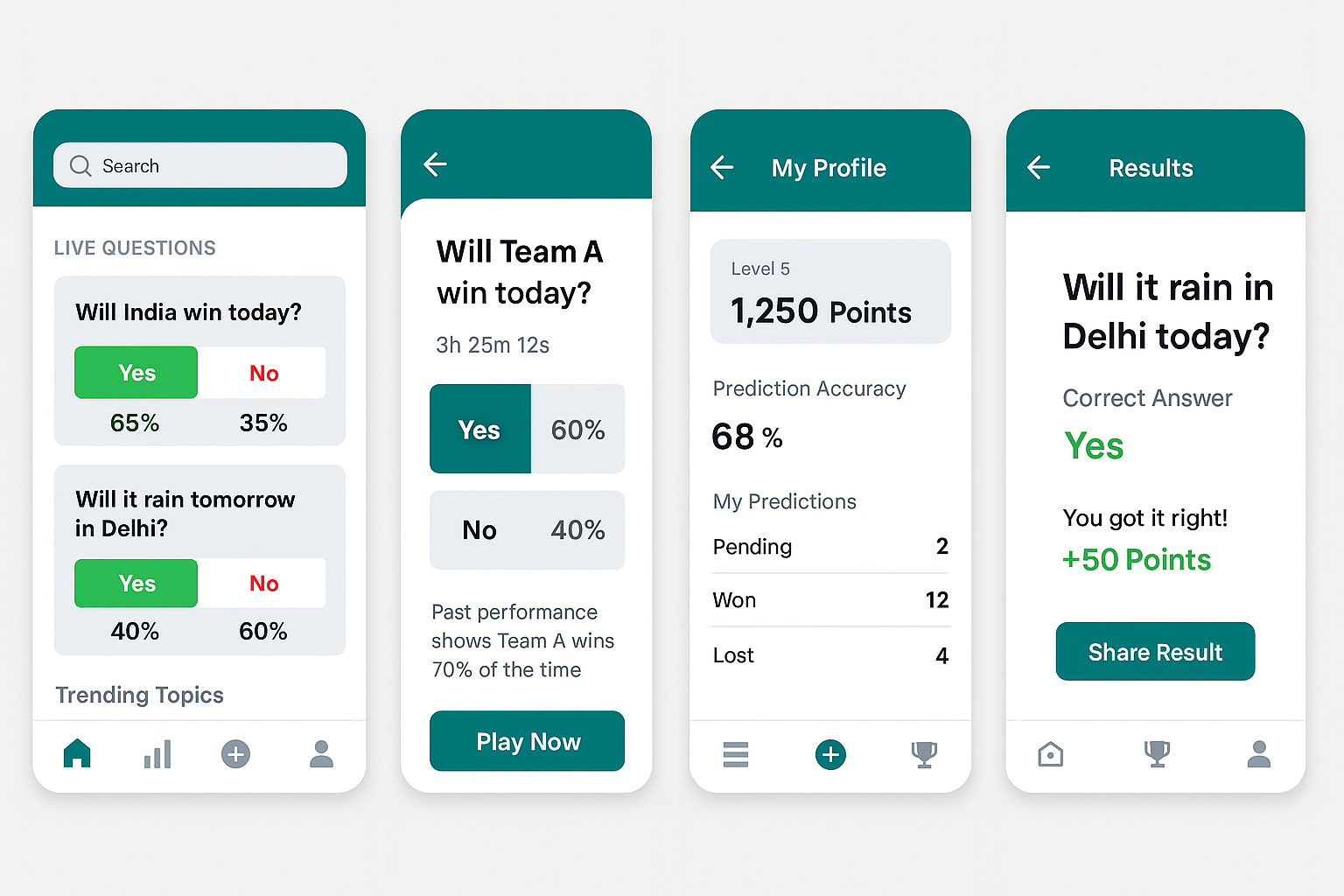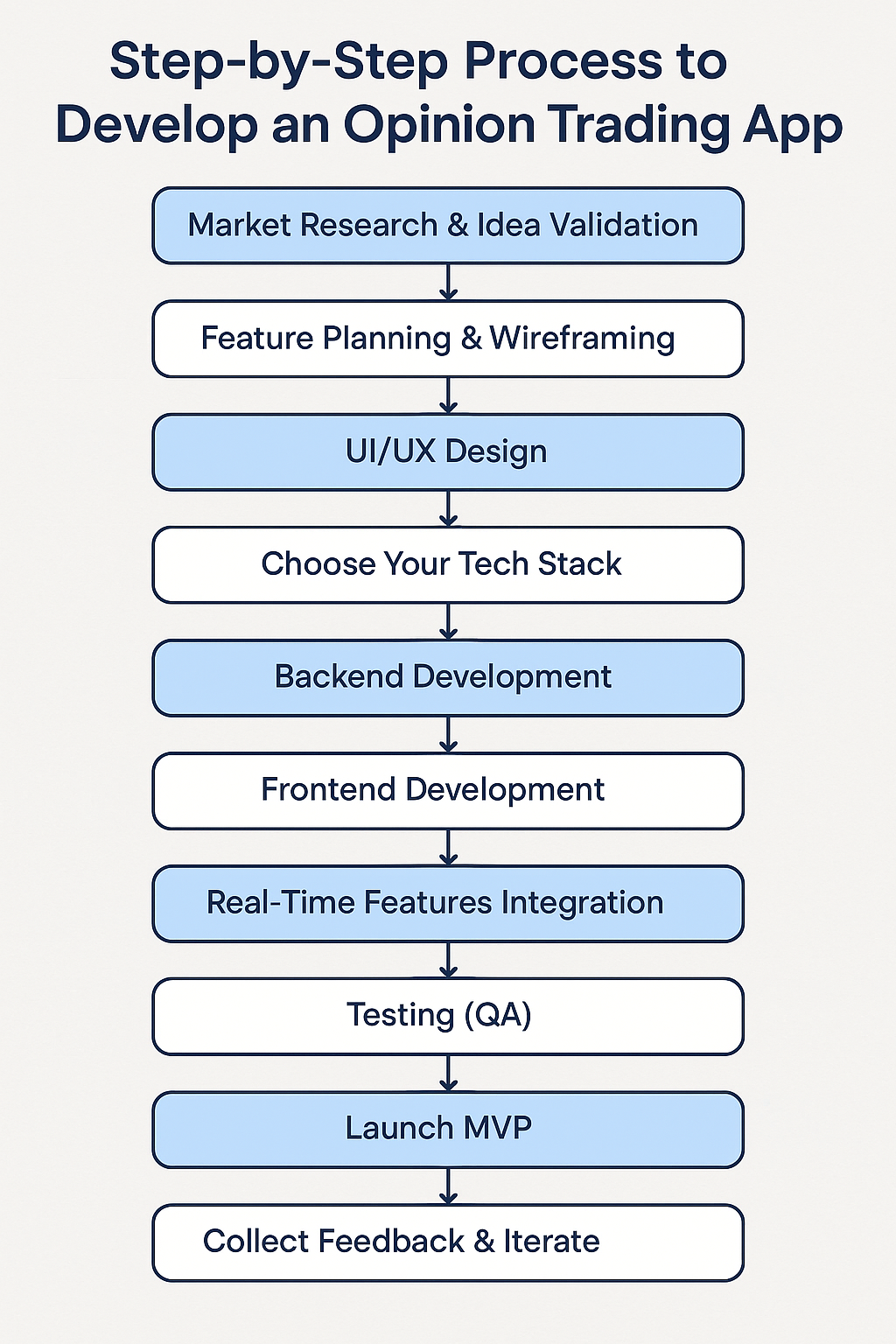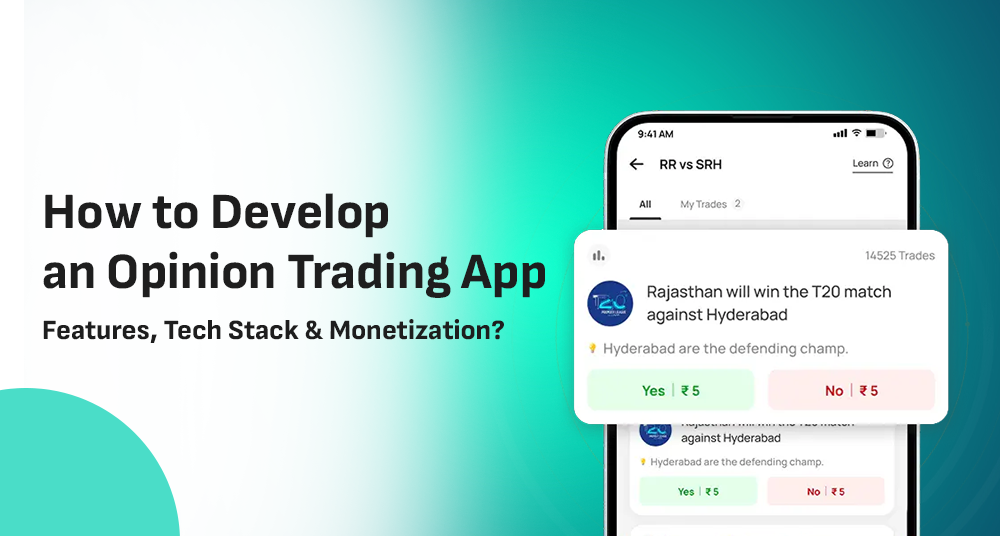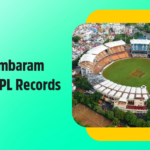In today’s digital economy, gamified finance is on the rise, and opinion trading apps like Probo, MPL Opinio, and SportsBaazi are leading the way. These platforms let users trade on “yes or no” outcomes, from cricket match predictions to financial market forecasts, creating a new form of entertainment-driven investing. If you’re planning to build your own opinion trading app, you’re tapping into a rapidly growing niche that blends fintech, real-time engagement, and social prediction. In this guide, we’ll walk you through the essential features, recommended tech stack, monetization models, and key considerations to help you bring your opinion trading app idea to life.
What Is an Opinion Trading App?
An opinion trading app is a platform where users share their thoughts on real-world questions and see how others think, too. These apps usually ask yes or no questions like “Will it rain tomorrow in Delhi?” or “Will India win the next cricket match?” Users then choose their answer based on what they believe will happen.
If your opinion turns out to be correct, you earn points or rewards. The fun part is watching how others are voting in real-time, changing your answer before the deadline, and testing how good you are at predicting outcomes. It feels like a mix of a quiz game and a live challenge—all based on real events happening around you.
How Does an Opinion Trading App Work?

An opinion trading app works by letting users take part in real-time questions based on current events, like sports, news, or general trends. The app shows a yes or no question, such as “Will Team A win today’s match?” or “Will this movie release next Friday?”
Here’s how the process usually works:
- Browse Questions
Users open the app and explore live questions that are available to answer. - Give Your Opinion
They pick “Yes” or “No” based on what they believe will happen. - Track What Others Think
The app shows live stats of how many people chose each option, building excitement and curiosity. - Wait for the Result
Once the event finishes or the outcome is confirmed, the app announces the correct answer. - Get Rewards or Points
If the user’s prediction was right, they earn points, move up the leaderboard, or unlock achievements — depending on the app’s system.
This simple process turns everyday opinions into an interactive experience, making it fun and engaging to follow real-world events.
Key Features to Include in an Opinion Trading App
To develop a successful opinion trading app, it’s important to include features that make the platform engaging, smooth, and scalable. Below are the key features every development team should consider:
Live Opinion Market
The Live Opinion Market is the heart of any opinion trading app. It shows users a list of real-time questions they can vote on—usually with simple “Yes” or “No” options.
For example:
“Will India win today’s match?”
Users can tap Yes or No based on what they think will happen.
All the questions are active for a limited time, and the results are decided after the actual event ends. Users can also see how others are voting—like 70% yes, 30% no—which makes it exciting and competitive.
This section is updated live, so users always have something new to play with. It keeps them engaged and coming back regularly.
Simple Yes/No Voting Interface
This is the part of the app where users make their choice—either yes or no—for each question. It should be clean, fast, and easy to use.
For example, the app shows a question like,
“Will it rain in Mumbai tomorrow?”
The user just taps Yes or No—that’s it!
There are no long forms or confusing steps. Everything is designed to work with just one tap, so even a first-time user can quickly participate.
Countdown Timer
The Countdown Timer shows how much time is left to vote on a question. Every question in the app is time-based — once the timer hits zero, users can no longer submit their answer.
For example:
“Will India win the toss today?”
The timer might show 00:03:25 (3 minutes and 25 seconds left to vote)
This creates urgency and encourages users to make quick decisions before the deadline. It also ensures that all answers are locked in before the real event starts, keeping the game fair.
The timer should update live and be clearly visible on every question.
Result Announcement & Validation
After a question’s time ends and the real-world event is over, the app shows the correct answer—this is called the result announcement.
User Dashboard
The user dashboard is the personal space where each user can see their activity and progress inside the app.
It shows helpful stats like:
- Total questions answered
- Number of correct predictions
- Accuracy rate (e.g., 75% correct)
- Points or rewards earned
- Active, completed, and upcoming predictions
This section helps users track how well they’re doing and keeps them motivated to play more. Some dashboards also show badges, levels, or achievements based on user performance.
Reward System or Point Engine
The Reward System is what makes the app fun and motivating. When users make correct predictions, they earn points, badges, or level-ups based on their performance.
For example:
- Correct answer: +50 points
- Wrong answer: 0 points
- 5 correct in a row? Unlock a bonus badge!
These points help users climb the leaderboard, unlock achievements, or get special status inside the app (like “Pro Predictor” or “Top Player of the Week”).
You can also add:
- Daily check-in rewards
- Streak bonuses
- Referral rewards
Leaderboard
The leaderboard shows a ranked list of top-performing users based on their points or prediction accuracy. It adds a fun, competitive edge to the app and motivates users to keep playing.
Push Notifications
Push notifications are quick alerts sent to users to keep them informed and engaged—even when they’re not using the app.
For example, users can get notifications like
- “New question available: Will India win the toss today?”
- “Only 5 minutes left to vote on today’s cricket match!”
- “You got it right! 50 points added to your account.”
- “You’ve moved up to Rank #15 on the leaderboard!”
These alerts help bring users back into the app, remind them to vote, and celebrate their wins—all in real time.
Admin Panel
The Admin Panel is the control center of the Opinion Trading App. It’s where the app owner or admin team can manage everything behind the scenes.
Here’s what an admin can do from the panel:
- Create and manage questions (e.g., add daily “Yes/No” polls)
- Approve results once real-world outcomes are known
- Manage users, view their activity, and handle reports
- Track app performance (daily active users, questions answered, etc.)
- Update categories, topics, and notification settings
Best Tech Stack for Opinion Trading App Development
Choosing the right tech stack is one of the most important steps in developing a high-performing, real-time opinion trading app. Your technology choices will directly impact app speed, scalability, user experience, and long-term maintenance.
Here’s a breakdown of the ideal tech stack:
Frontend (User Interface)
This is what users see and interact with.
- React Native—for building cross-platform apps (Android + iOS) with a single codebase
- Flutter—Another great option for smooth UI and fast performance
- HTML5 + CSS + JavaScript—for web-based admin panels or dashboards
Use clean UI libraries and mobile-friendly design systems for better engagement.
Backend (Server-side Logic)
Handles question management, user data, voting logic, and result processing.
- Node.js—Fast, scalable, and perfect for real-time apps
- Python (Django/Flask)—Great for handling business logic and APIs
- Express.js—Works well with Node for creating REST APIs
Ensure secure handling of user data and predictions.
Database
Stores all your app data, like users, votes, questions, and results.
- MongoDB—A flexible NoSQL database, great for apps with dynamic data
- PostgreSQL—A powerful SQL database if your app needs more structured data
Use indexed queries and caching to speed up performance.
Real-Time Data Updates
Opinion trading apps need live vote counts and result updates.
- Socket.IO—Enables real-time two-way communication between users and server
- Firebase Realtime Database—Great for live updates, especially in MVPs
Push Notifications
Keeps users engaged with alerts about new questions, results, and rewards.
- Firebase Cloud Messaging (FCM)
- OneSignal
Authentication & Security
Verifies users and protects their accounts.
- Firebase Auth or JWT (JSON Web Tokens)
- OAuth 2.0 for social login integration (Google, Facebook, etc.)
Admin Panel (Web Dashboard)
Used to manage questions, results, users, and app data.
- React.js or Angular—for building responsive and interactive admin dashboards
- Chart.js/Recharts—for visualizing stats and performance
Cloud & Hosting
Reliable infrastructure for running your app.
- AWS/Google Cloud/Azure—for cloud storage, backend hosting, and scaling
- Heroku/Vercel—for easy deployment in smaller projects or MVPs
Step-by-Step Process to Develop an Opinion Trading App

Here’s a clean and easy-to-understand explanation in subpoints:
1. Market Research & Idea Validation
Start by understanding your target users. Research existing apps like Probo, assess their strengths/weaknesses, and define your unique value proposition (e.g., niche categories, regional content, UI/UX).
2. Feature Planning & Wireframing
Outline key features — like Yes/No polls, countdown timers, user rewards, leaderboards, and real-time updates. Then design basic wireframes or low-fidelity prototypes to map out the app flow.
3. UI/UX Design
Create a visually appealing and intuitive design. Keep user journeys short and clean. Focus on a mobile-first approach with minimal navigation to keep engagement high.
4. Choose Your Tech Stack
Pick technologies for frontend, backend, database, and real-time communication (as discussed earlier). Choose tools based on scalability, performance, and developer availability.
5. Backend Development
Build the app’s core logic:
- Question creation & scheduling
- Vote submission & result processing
- User profile & points management
- Admin panel integration
Use secure APIs and a modular code structure.
6. Frontend Development
Connect the backend with your user-facing app. Integrate:
- Voting interfaces
- Timers & live status
- Dashboard & history
- Notifications
Ensure it’s responsive across all screen sizes.
7. Real-Time Features Integration
Use tools like Socket.IO or Firebase to allow live vote counts, countdown clocks, and result updates without needing to refresh.
8. Testing (QA)
Conduct thorough manual and automated testing to fix bugs, improve performance, and ensure smooth functionality across devices. Test all edge cases (like vote ties or network issues).
9. Launch MVP
Start with a Minimum Viable Product (MVP) to get early feedback. Launch in a controlled user base or via beta testers.
10. Collect Feedback & Iterate
Monitor user behavior, fix early issues, and add improvements like new voting categories, user incentives, and performance upgrades.
11. Post-Launch Support & Marketing
Set up analytics, push campaigns, and app store optimization. Keep your app updated with new opinion topics and timely features (e.g., live cricket polls, political trends).
Monetization Strategies for Your Opinion Trading Platform
To make your opinion trading app financially sustainable, you need smart revenue strategies. Here are the most effective monetization models:
1. In-App Purchases
Allow users to buy virtual coins, tokens, or points that they can use to participate in premium opinion markets, unlock exclusive polls, or access advanced insights.
2. Freemium Model
Offer basic opinion markets for free but keep some advanced features — like leaderboards, special categories (e.g., politics or finance), or early market access — behind a paywall or subscription.
3. Subscription Plans
Provide users with premium access on a weekly, monthly, or yearly basis. Subscriptions can offer:
- Ad-free experience
- Early access to trending polls
- Bonus rewards
- Exclusive contests
4. Referral Rewards and Loyalty Programs
Encourage user growth by offering rewards for inviting friends. You can also create tier-based loyalty systems that unlock benefits the more users engage.
5. Third-Party Sponsorships or Brand Campaigns
Brands can sponsor specific opinion markets. For example, a cricket gear brand could sponsor an IPL prediction market — giving both visibility and engagement.
6. Advertising (Carefully Integrated)
You can use non-intrusive ads like:
- Banner ads on home/dashboard
- Sponsored opinion polls
- Rewarded video ads (watch to earn bonus points)
Just ensure ads don’t interrupt the user experience.
7. Partnered Content or Influencer Collaborations
Collaborate with influencers or creators who bring their own opinion markets and drive traffic. You can offer them a share of the engagement revenue.
8. Premium Data & Analytics Access (B2B)
If your app gathers rich user insights or opinion trends, you can package anonymized data for partners like news outlets, researchers, or advertisers (ensure user privacy).
Cost to Develop an Opinion Trading App
The overall development cost of an opinion trading app can vary widely—depending on several key factors. Here are the main elements that influence your app development budget:
1. App Complexity
The more features you want (like live opinion markets, leaderboards, dashboards, or custom polls), the more time and resources it takes to build—which increases the overall effort.
2. Design & UI/UX
A smooth, intuitive, and visually appealing interface plays a crucial role in user engagement. More personalized, animated, or interactive designs typically require more work and skilled design teams.
3. Platform Choice (Android, iOS, or Both)
Building the app for both iOS and Android increases development scope compared to a single platform. Native apps are more expensive to develop than cross-platform solutions.
4. Backend Infrastructure
If your app supports real-time polling, user management, notification systems, and secure data handling, it will require a robust backend setup—possibly cloud-based for scalability.
5. Third-Party Integrations
Integrating APIs such as for login (Google/Facebook), push notifications, analytics, or referral systems adds to development time.
6. Admin Panel Development
Creating a powerful admin dashboard to manage users, polls, reports, and analytics adds another layer of development—especially if it’s role-based or includes real-time data visualization.
7. Team Size & Location
Working with an experienced opinion trading app development company or hiring a dedicated team affects costs depending on their skill level, team structure, and geographic location.
8. Post-Launch Maintenance
After launch, your app will require updates, bug fixes, performance optimization, and possibly new feature rollouts — all of which impact ongoing costs.
Trending Opinion Trading Apps in the Market
1. SportsBaazi
A popular platform offering sports-based predictions and opinion trading, especially focused on cricket and football fans.
2. MPL Opinio
MPL‘s own opinion-based prediction app, allowing users to express views and earn rewards by answering yes/no questions on live events.
3. Probo
One of the pioneers in the opinion trading space, Probo lets users take positions on questions around news, sports, finance, and more.
4. PlayerzPot
Offers both fantasy sports and opinion-based prediction contests, making it a hybrid app for all types of sports lovers.
Final Words
Opinion trading apps are rapidly redefining how users engage with real-world events—offering a fun, interactive, and gamified experience around predictions. Whether it’s a simple yes/no vote or a trending cricket opinion market, these platforms have massive potential to attract and retain a dynamic user base.
If you’re planning to build your own opinion trading app, focusing on the right features, scalable tech stack, and a thoughtful monetization strategy is essential. With the right development partner, your idea can turn into a powerful platform that not only engages users but also opens new doors for innovation in digital interaction.
Frequently Asked Questions (FAQs)
- What is an opinion trading app?
An opinion trading app allows users to participate in real-time polls or prediction-based questions—typically in a yes/no format—based on trending topics like sports, politics, or entertainment. - How long does it take to build an opinion trading app?
Development time can range from a few weeks to several months, depending on app complexity, features, and platform (iOS, Android, or both). - Which tech stack is best for opinion trading app development?
Popular choices include React Native or Flutter for front-end, Node.js or Laravel for backend, and Firebase or AWS for real-time data syncing and hosting. - Can I include sports-specific opinion polls in the app?
Yes, you can customize the app to focus on specific verticals like cricket, football, or even niche categories such as IPL match predictions or political forecasts. - What features should I prioritize during the MVP stage?
Start with essential features like user registration, live opinion markets, yes/no voting, countdown timers, a basic dashboard, and result display. - How can I monetize my opinion trading app?
You can earn through in-app advertisements, sponsorships, subscription plans, affiliate links, or engagement-based reward models.



